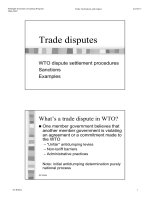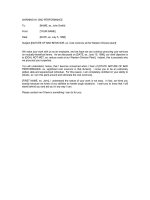Tài liệu Office Management ppt
Bạn đang xem bản rút gọn của tài liệu. Xem và tải ngay bản đầy đủ của tài liệu tại đây (169.95 KB, 13 trang )
517
20
Office Management
J
OHN
B
ASCHAB AND
J
ON
P
IOT
There is no substitute for the comfort supplied by the utterly taken-for-granted relationship.
—Iris Murdoch,British novelist
This chapter discusses the key attributes of running an efficient and organ-
ized office. Your office(s) first and foremost needs to be a productive work
environment for your staff. When hiring a new employee is the space, phone
extension, and computer ready for them on the day he or she arrives—or are
you scrambling to get these things set up during their first couple of weeks
on the job?
Further, the professional services firm office is your face to clients and
prospective and existing staff. It reflects either organization or disorganiza-
tion, confidentiality, or lack thereof or it reflects simplicity or complexity.
What catches your client’s attention when entering your office space? What
first impression does your office and staff leave?
Office management includes support services such as managing and main-
taining the facility; organizing and managing the administrative staff; ensur-
ing proper services are provided such as phones, offices, and document
reproduction centers. Office management may also include some of the softer
aspects of running the firm including fostering the firm’s culture and captur-
ing and maintaining the history of the firm. For smaller firms, office manage-
ment duties are typically combined with other functions (e.g., book-keeping)
that can be carried out by one person. In larger firms, office management
may actually be the function of a dedicated full-time employee or a depart-
ment of employees. In this chapter, we discuss many of the basic services
provided by the office management function and the growth points in the life
of the firm when transitioning from part-time staff to full-time staff and
other organizational actions are appropriate.
518
The Back Office: Efficient Firm Operations
Why Is This Topic Important?
This topic doesn’t receive the attention it deserves because it is a support
function. The bulk of professional services firm management attention, in-
vestment and discussions will appropriately focus on billable activity and
business development. However, business development will suffer if one
walks into a poorly run professional services office and notices immediately
that no one is attending to the reception area, the phones are not answered
consistently, and the space looks cluttered and unorganized. A disorganized
office begs the question: If the firm is willing to treat its own offices this
poorly, how well can it possibly service client accounts? Conventional think-
ing would suggest that running a simple function such as answering the
phone or maintaining an impressive reception area should be an easy act for
a professional services firm. Doing the work of the firm, selling, and working
with clients is complicated; managing the office is not. Or is it?
Rarely does the “plant” run as smoothly as one wishes. Many important
duties can get complicated due to inattention, time demands or office poli-
tics, for example:
• Assigning offices
• Optimizing administrative staff assignments
•Prioritizing duplication services
• Executing common tasks, such as new employee onboarding or recruit-
ing events
•Filing confidential client or employee information
What can appear to be a simple office change for one attorney or consul-
tant can cascade into a mess of negotiations and disgruntled workers who
don’t want to be moved or don’t like their office assignment.
A well-run office management function is important for four key reasons:
1. It helps keep your billable staff from focusing on unproductive office
and administrative matters.
2. The reception area and workspace are transparent to the client and re-
flect on the firm.
3. The organization of the workspace can increase staff productivity or
hinder it.
4. The function can be (and most often is) a central force in promoting a
culture.
A professional service firm maximizes profits by ensuring the profession-
als are as billable as possible. Their time is not well spent on office or facil-
ity issues. So the a critical objective for the office manager is to keep the
Office Management
519
profes
sionals from having to spend precious time on nonbillable office man-
agement issues. Additionally, the office manager’s goal is to provide services
that make the job easier, or to facilitate doing components the job using a less
expensive resource (i.e., graphics specialist, research analyst, typist).
This chapter provides an overview of the office management function. We
discuss the typical support services provided, facility management best prac-
tices, and the hiring of office managers.
What Is Office Management?
Office management consists of three primary functions. First, office man-
agers typically provide support services to the rest of the employees. These
services include administrative support, scheduling, print and document re-
production services, design/graphics support, telecom, mail, and so on. Sec-
ond, the office manager maintains the physical facility and manages the
landlord and building services. Maintaining the facility encompasses space
planning, maintenance, office moves, security, storage, vending and coffee
service, break rooms, and so on. Finally, the office manager in some cases
may be responsible for other duties such as coordinating local office social ac-
tivities, celebrating major firm events, publishing firm newsletters, maintain-
ing a history of the firm, and providing meeting space outside the building, to
name just a few of the other miscellaneous duties.
Support Services
Support services are those common services that can be leveraged across all
the staff. They are typically items that can be centralized relatively easily
and they use standard processes to control scheduling and quality.
Support services are also activities that need to be routinely performed to
support the professional staff in the normal course of their work (e.g., docu-
ment duplication and filing). Support services sometimes require the acqui-
sition of capital equipment (e.g., copying machines, graphics workstations,
postal equipment). Plotters, high-end printing, paralegal services are just a
few examples of support services.
When deciding which activities to support at a centralized office level,
consider those which:
• Are required by all staff.
• Exhibit economies of scale.
• Can be effectively executed by lower-cost administrative staff than by
professional staff.
• Are experiencing labor pool scarcity.
520
The Back Office: Efficient Firm Operations
In most cases, any service that is required by all staff should be supported
if not managed centrally. If most client work requires some kind of graphics
production for reports, in most cases, it will be appropriate to have a graph-
ics production group managed centrally. This ensures a unified look to
graphics and that best practices can be easily adopted and adhered to, as
well as achievement of scale economies in production. If this function is not
centralized, then each professional staff group or project team would need to
hire their own graphics production resource wasting valuable time and in-
creasing costs.
Support services typically have some economies of scale, for example,
copy machines. You wouldn’t want each principal in the firm purchasing his
own copy machine (with the resulting disparity of machine types, speeds,
service plans, etc.). The benefits of centralizing purchasing and management
where there are economies of scale is well-explored territory. Obviously, by
grouping the purchase better pricing can be negotiated and volume dis-
counts will apply lowering overall purchasing costs. Additionally, the expen-
sive equipment can be located optimally so that appropriate staff can access
and use it easily. Finally, this keeps your expensive professional staff billing
clients for services, and not negotiating equipment leases.
Support activities also experience economies of scale in labor. For ex-
ample, rather than hiring three half-time personnel to do estimating, you
can centralize the function and do the same amount of work with one full-
time person thus saving the fractional utilization of a half person. These ac-
tivities are labor intensive and the firm can reduce costs by managing a
centralized highly leveragable unit. These services include postal mail
management, graphic production, paralegal services, administrative ser-
vices, and so on.
Finally, you need to consider availability (or scarcity) of resources when
analyzing centralization. For example, if most professional staff need a small
but critical function for each client engagement, for example a project finan-
cial controller, and the labor pool for this function is small, the firm will be
better off hiring one full-time equivalent and leveraging that resource across
the business rather than having each principal try to procure the resource in-
dividually. Decentralization in this case would lead to low utilization of a full-
time resource or the procurement of many high-cost part-time contractors
neither of which is desirable. If each client proposal or project needs some
specialized research for a short period of time, the firm is likely to create a
centralized support group that provides research rather than having each
principal hire their own research associate.
The most common support services include:
•Administrative staff management
•Document reproduction
Office Management
521
•Travel booking and trip management
•Mail rooms
•Record keeping and document management
Administrative Staff Management
It is almost always more efficient to centrally manage the administrative
staff. The job function of the entire administrative staff is usually similar,
the pool of staff can share responsibilities, they typically have standard du-
ties, and they keep the professionals billable and efficient. Professionals are
notoriously poor managers of administrative staff, and will benefit from the
improved attention to administrative staff management, careers and devel-
opment accompanying a centralized management approach.
Developing standard administrative roles across the company is a best
practice. The office manager can do this relatively easily. First, define the
work requirements of each type of administrative staff. Next figure out the
duties needed to support each level of professional staff and the required
hours per week needed to support each professional staff type. For exam-
ple, an associate may only receive filing and travel support thus requiring
only four hours a week. A senior associate may require calendar scheduling
assistance and expense management assistance thus requiring about eight
hours a week of an assistant. A principal requires all of the above plus dic-
tation, presentation support, marketing campaign support, and so on,
thereby consuming at least 20 hours per week. Given this load, a single as-
sistant could handle only one principal, two senior associates, and one asso-
ciate. Alternatively an assistant could handle one principal, one senior
associate, and three associates. The ratio that works for a given will depend
on the specific type of work, number of professional staff and administra-
tive burden for each.
Typically junior professional staff only receive basic administrative ser-
vices (mail delivery, photocopying), while senior staff receive the full suite
of services from the administrative team.
Document Reproduction
Document reproduction, copier centers, and scanning stations are provided
through similar products and service models, and are well suited for central
office management. Some firms charge out these services while others factor
the cost into their services. Regardless, the most critical aspect of running
one of these services is the process for requests, the turnaround time, the
delivery of finished product, and billing for the services. Most firms will de-
termine that the tradeoff of a $10 to $20 per hour resource doing this work is
well worth saving the high cost of a professional doing the same.









